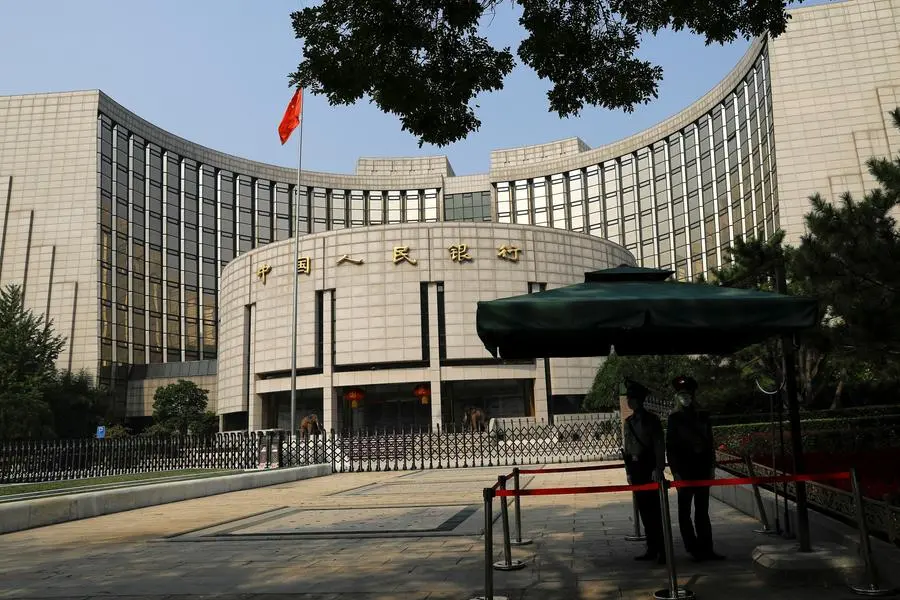PHOTO
BEIJING/SHANGHAI - A scarcity of low-risk assets in China's financial sector is obstructing the central bank's plans to make its monetary policy toolkit more efficient with a return to the treasury bond market after a 17-year hiatus.
Taking its cue from an October 2023 speech by President Xi Jinping, the People's Bank of China (PBOC) pledged recently to add treasury bond buying and selling to its toolkit, to improve an increasingly flawed monetary policy transmission mechanism.
PBOC trading - different from the quantitative easing moves seen in the West - would help deepen the bond market by improving liquidity and reducing volatility, drawing in more issuers and investors to help firms and other entities reduce their reliance on less efficient bank lending for raising funds.
But there's a problem: China's central government has tasked riskier local government issuers with funding investment projects for decades, making their debts unsustainable, while keeping its own balance sheet light.
Its bond issuance is only just picking up.
As a result, there are no liquid-enough - and therefore reliable - benchmarks to build a lively bond market around.
This means the central bank's planned upgrade of the arsenal it fights with to reflate the world's second-largest economy is a more medium-term ambition rather than a quick fix, and will proceed slowly.
"Using treasury bond trading as the main market operation tool would greatly improve the PBOC’s monetary policy framework, especially the interest rate transmission," said a policy adviser, asking for anonymity to discuss a sensitive topic.
"But conditions are not ripe. We have an asset famine."
The PBOC did not immediately respond to a request for comment.
In a May 8 statement to Reuters, it said bond trading "can be used as a liquidity management method and a reserve of monetary policy tools." It added trading would be "two-way."
The latest example of distortions in the Chinese bond market emerged last week with the debut of the first batch of ultra-long treasury bonds this year, when prices immediately surged 20% on illiquid exchanges, sending yields below central bank policy rates and triggering trading suspensions.
More issuance is scheduled through November until it reaches 1 trillion yuan ($138 billion) in total - or around 0.8% of gross domestic product.
State media quoted an unidentified central bank official in April saying government bond issuance must be large and steady to avoid sharp interest rate volatility.
INEFFICIENT LENDING
The dominance of credit in the Chinese economy, with most flows controlled by state banks, has long been a source of concern over capital misallocation and a headache for the central bank, whose repeated rate cuts and liquidity injections have struggled to temper deflation fears.
Analysts say cheap credit continues to flow towards state-owned firms with large production capacity, irrespective of the quality of their projects. At the same time, private firms that might want to expand get less generous terms for loans as banks perceive them to be more risky.
Also, large sums are idle in the financial system rather than flowing to the real economy, the central bank has said.
"What corporates in China actually seem to be doing is taking cheap 2-3% bank loans and channeling the money back into banks’ wealth management products, long-term time deposits, or other investment products," Rhodium Group analysts wrote.
BIG AND DRY
Chinese entities are the world's second-largest bond issuers after the United States, piling up about 106 trillion yuan, or 84% of GDP, according to data from Chinabond, including nearly 30 trillion yuan in treasury bonds.
But the issuance is mainly dominated by local governments and their financing vehicles and policy banks, while the buyers are mostly banks which tend to hold them until maturity.
In effect, this is not too different than bank lending.
Only a fraction of these bonds are actively trading in untransparent secondary markets, traders and analysts say.
The PBOC last bought bonds in 2007 for the creation of the sovereign wealth fund China Investment Corp. Its total holdings stand at 1.52 trillion yuan, roughly 3.5% of its total assets.
Using them to boost liquidity in secondary markets and better manage the yield curve is tricky given the low turnover. Selling might result in a spike in yields, and therefore a tightening of financial conditions at a time when China's growth target of around 5% seems challenging.
Buying may push yields too low - and widen an already negative 200 basis points differential with U.S. benchmarks that has raised capital outflow concerns which are pressuring the yuan currency.
One way forward for the PBOC would be to wait for more issuance to hit the market, limit itself to small moves, and choose the timing of any purchases carefully, to avoid triggering talk of deficit monetisation.
"We should use treasury bonds as a policy tool, but we should also keep a rein on money supply," another policy adviser said, pointing to hyperinflation in the 1980s and 1990s, when there was no separation between fiscal and monetary policy.
Shuang Ding, chief economist for Greater China and North Asia at Standard Chartered, expects the PBOC to "initially buy a small amount, and trade both ways."
It would take a "relatively long period of time" for PBOC trading to "serve as a tool to inject liquidity," he said.
Ting Lu, chief China economist at Nomura, expects the PBOC to start bond trading "perhaps within the next six months, though the timing is highly uncertain."
"The PBOC might choose a time of volatile interbank rates to start trading" to stabilise the market, he said.
($1 = 7.2448 Chinese yuan renminbi)
(Additional reporting by Winni Zhou and Li Gu in Shanghai; Editing by Marius Zaharia and Kim Coghill)












